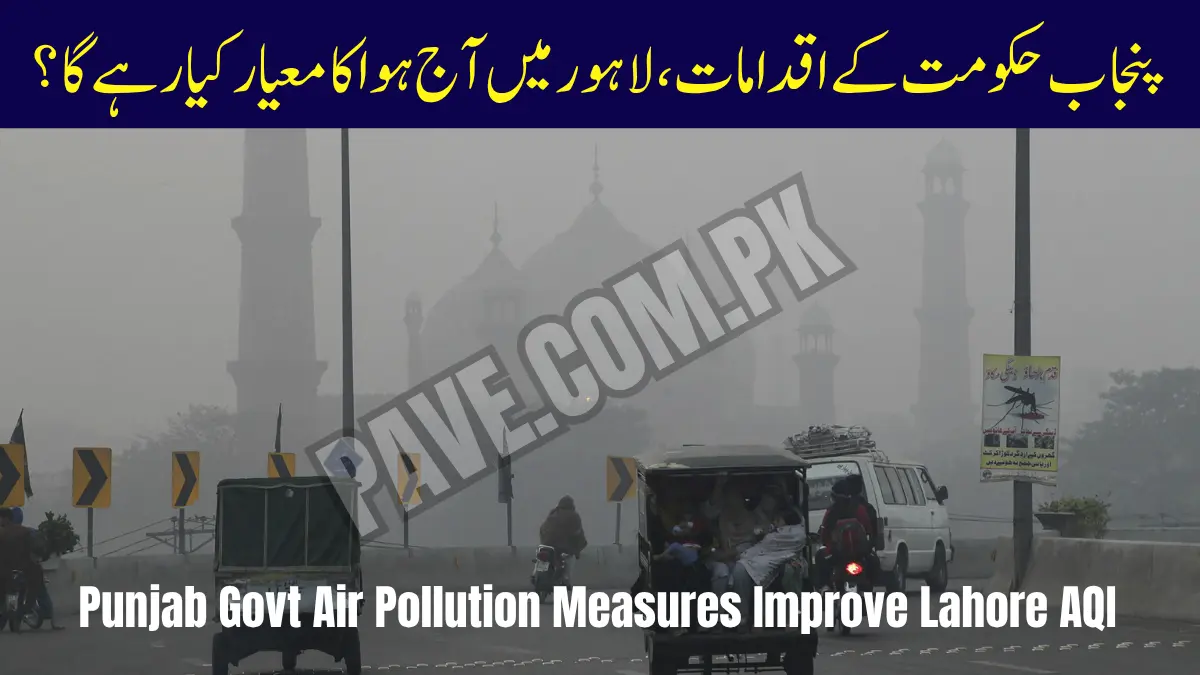Punjab Govt Air Pollution Measures Improve Lahore AQI
The Punjab government’s air pollution control measures have begun to yield tangible results as Lahore’s air quality showed visible improvement today. Following days of dense smog and high particulate matter levels, the latest readings indicate that the Lahore AQI (Air Quality Index) has fallen to an average range of 220–240, marking a notable reduction compared to the severe pollution levels earlier this week.
Officials attribute this improvement to the province’s ongoing anti-smog operation, strict enforcement of environmental regulations, and favorable weather conditions that helped disperse pollutants.
Punjab Govt Air Pollution Measures Show Results
Under the direction of Chief Minister Maryam Nawaz, the Punjab government’s environmental measures have been implemented aggressively across major cities. The Environment Protection Department (EPD), in collaboration with local administrations, launched large-scale operations targeting industrial emissions, vehicular smoke, and open burning.
Anti-smog guns have been deployed in high-risk zones of Lahore, while water sprinkling continues on major roads, underpasses, and construction sites to minimize dust levels. The government has also intensified its crackdown on factories operating without emission control systems and banned the burning of crop residue and solid waste.
According to EPD officials, these actions have already led to a 15–20% decline in PM2.5 levels across the provincial capital.
Weather and Wind Patterns Aid Improvement
Meteorological data suggests that weather conditions have played a supportive role in stabilizing Punjab air quality today. Light east-to-west winds are moving at an average speed of 5 to 8 kilometers per hour, helping disperse accumulated pollutants.
The morning hours still recorded moderate haze and low visibility, but conditions improved by midday as the temperature rose to 32°C and wind activity increased to 11 km/h.
Officials warn that the air quality could worsen again during evening rush hours due to heavy traffic, commercial vehicle movement, and industrial activity. However, authorities expect overall improvement in the coming days if current weather patterns continue.
Cross-Border Smog Adds to Local Pollution
Experts highlight that cross-border smog from India’s northern states remains a persistent challenge. Following Diwali celebrations and continued stubble burning in Haryana and Punjab (India), air currents have carried pollutants toward Lahore, Faisalabad, and Gujranwala.
Winds blowing from Himachal Pradesh and Ludhiana at 5–9 km/h have increased pollutant concentration in eastern Punjab districts. The Punjab government, however, maintains that its anti-smog operation has prevented further deterioration in AQI levels.
Environmental analysts emphasize that sustained inter-regional coordination and regional dialogue are necessary to effectively manage cross-border air pollution during the smog season.
Anti-Smog Operation Punjab in Full Force
The anti-smog operation Punjab remains ongoing with daily inspections and strict compliance monitoring. Provincial task forces are ensuring enforcement of the Punjab Environmental Quality Standards (PEQS), while mobile teams are conducting random checks at industrial sites and transport hubs.
According to official data, dozens of brick kilns and steel furnaces have been sealed for violating emission limits, while heavy penalties have been imposed on vehicles emitting black smoke.
Traffic authorities have restricted heavy truck movement during high-smog hours, particularly between 6 PM and 10 PM, to minimize congestion-related emissions. Additionally, public awareness campaigns through local media and billboards are urging citizens to adopt eco-friendly practices.
Read More: Today Gold Rate in Pakistan 22 October 2025 — Latest Per Tola & Gram Prices
Air Quality Monitoring and Public Advisory
Real-time air quality data from Lahore’s monitoring stations show a clear downward trend in pollution levels. Compared to last week’s average AQI of 285–310, today’s readings between 220 and 240 suggest partial recovery.
Health officials advise residents, particularly children, elderly citizens, and heart or respiratory patients, to limit outdoor activities during morning and evening hours when pollutant concentration tends to rise.
Precautionary guidelines include:
- Wearing protective masks outdoors.
- Keeping windows closed during peak pollution hours.
- Using air purifiers indoors when possible.
- Avoiding physical exertion during smog-heavy periods.
Punjab Government’s Broader Environmental Vision
The provincial administration’s ongoing air pollution control campaign is part of a larger environmental reform plan. The Punjab Clean Air Initiative aims to transition towards green infrastructure, renewable energy, and low-emission public transport systems over the next five years.
Senior Provincial Minister Maryam Aurangzeb stated that the government’s goal is not only to tackle seasonal smog but to establish a sustainable environmental framework:
“Our focus is on prevention, not reaction. Through enforcement, awareness, and innovation, Punjab will lead the way in clean air initiatives for all cities.”
Long-term plans include promoting electric public buses, enforcing vehicle fitness certifications, and launching urban plantation drives to expand Lahore’s green cover.
Expert Analysis
Environmental policy expert Dr. Fahad Mehmood observed that while short-term actions like anti-smog operations are effective, they must be paired with policy continuity and industrial modernization to achieve lasting change.
“Punjab has made significant progress this season, but permanent improvement requires sustained reforms—particularly in transportation, waste management, and urban planning,” he said.
He added that public awareness and participation play a crucial role, as behavioral changes in vehicle usage, waste disposal, and construction practices directly affect air quality.
Read More: Check Your Vote Today 2025
Outlook for Lahore and Punjab
If the current measures continue, Lahore’s air quality could gradually improve to moderate levels by the end of the week. However, authorities caution that colder weather and declining wind speed in late October could cause temporary deterioration.
The Punjab government has pledged to maintain 24/7 monitoring of AQI across all districts and expand anti-smog enforcement to rural areas, where burning agricultural residue remains common.
Officials assure that Punjab’s environmental teams will continue joint operations with local administrations, ensuring that emission standards and public safety remain top priorities.
Conclusion
The Punjab Govt Air Pollution Measures have begun to demonstrate impact, improving the Lahore AQI and offering a brief respite from the city’s chronic smog crisis. As authorities sustain their anti-smog operation Punjab, experts believe that consistent enforcement, regional cooperation, and citizen participation will be key to achieving long-term clean air objectives.
With improved monitoring, better compliance, and growing environmental awareness, Punjab’s air quality outlook today stands as a sign of cautious optimism — a reminder that proactive governance can indeed clear the air for millions.







